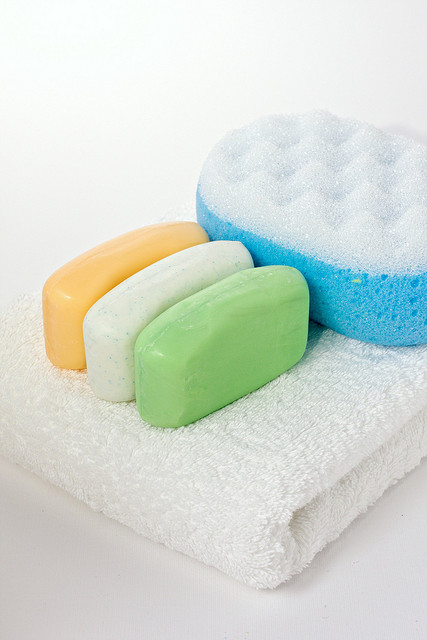Synthetic soap colorants can be used to great effect. Photo courtesy of Flickr user Horia Varlan.
Many soap makers prefer to use natural soap making colorants for their soaps, as opposed to synthetic ones. However, if the natural colorants don’t work for you, or are too expensive or unpredictable, there are a variety of synthetic colorants that can be used.
This post focusses on synthetic soap colorants, but you can read more about the various soap colorant options in our comprehensive post by clicking here.
Pigments, micas, and FD&C colorants are some of these.
Pigments are colorants that were originally mined, but now, due to FDA regulations, are manufactured in laboratories.
Many natural oxides contain toxic materials, so the FDA chose to approve only synthetic colorants for use in soaps and cosmetics.
The synthetically made pigments have the same molecular structure as the natural ones, but they have a low enough concentration of toxic metals that they are considered “safe” by the FDA. Pigments tend to be pretty stable, and the color that they will impart to your soap is predictable. The liquids are extremely easy to use, but the powders must be mixed with liquid before they are added to the soap batter, and they may clump.
The easiest way to liquefy the colorant powder is to:
Put a tiny bit of rubbing alcohol into a bowl – ¼ teaspoon is probably enough – and then add some powder.
Mix until all of the powder has dissolved in the alcohol. Mix the solution into the soap batter at the correct stage; if the batter is not your desired hue, mix more colorant solution. Another method of mixing the powdered colorant is to combine it with liquid glycerin, in a ratio of 2 parts glycerin to 1 part colorant powder. (The advantage of the liquid colorants is that this process is unnecessary; the colorant can be added, one drop at a time, until the soap has achieved the desired hue.)
FD&C colorants are also manufactured in a laboratory. By way of comparison, they are easier to use than many pigments, and provide a much wider range of colors. There is some debate over the safety of FD&C colorants, because in the past, the FDA has recalled some of these colorants due to safety concerns. However, this fear is, most likely, unfounded.
FD&C colorants are in almost all of the processed foods we eat, so the miniscule amount that is in soap is not really cause for concern.
FD&C colorants are inexpensive, and very easy to use; they are great for use in melt and pour soap, but they don’t usually remain stable in cold-process soap, due to its high alkalinity.
Micas are a combination of natural and synthetic materials. The micas themselves are natural material; after they are mined, they are then coated with FD&C colorants, or pigments, to provide them with color. Shimmery micas are normally used to give color to makeup, but can be used for soap as well. Because of their metallic sheen, micas can only display their color by reflecting light; therefore, they work best in translucent soaps. They blend very smoothly, but a larger amount is required than if you were coloring the soap with other colorants.
Micas also look nice in cold process soap, but because some of them are coated with FD&C colorants, they should be tested before use.
When the colorant you used transfers unintentionally, and alters the look of the intended design, this is referred to as bleeding, or color migration. This usually occurs in melt-and-pour soaps, because water is mixed with the soap base to melt it, and many colorants are water-soluble.
Therefore, if you want to make a soap that, instead of being a solid color, has a pattern or design, your best bet is to use colorants that are oil-soluble; another option is to use colorants that aren’t soluble, and color the soap via dispersion (meaning that the particles are suspended throughout the soap, instead of being dissolved in it). Oxides and most micas will color soap without bleeding.
Take the next step
Make sure you download our FREE comprehensive beginners guide, ‘How To Make Soap At Home’, by clicking here.
If you are ready to get serious about soap making, we have a special offer on our Soap Making Ebooks range, with a risk free 60 day money back guarantee! Also available for Kindle, iPhone, iPad, Android and all major Ebook reader platforms.
